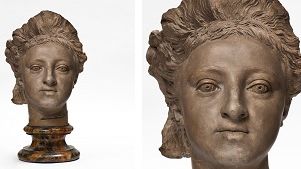
Press release -
New acquisition: Sergel’s portrait of Duchess Hedvig Elisabet Charlotta
At Bukowski’s autumn auction last year, Nationalmuseum acquired one of Johan Tobias Sergel’s few remaining clay models from a series of royal portraits, a bust that has been in private ownership until now. The portrait of the 21 year-old Duchess Hedvig Elisabet Charlotta has a freshness and immediacy, with clear traces of the sculptor at work.
When Johan Tobias Sergel was recalled to Sweden from Rome by King Gustav III, the sculptor hoped to be able to continue working on major themes from the ancient myths of gods and heroes. However, it perhaps came as no surprise to him that his future output in Sweden would take on a very different character. After all, the King had commissioned a portrait of himself just before Sergel left Rome on Midsummer’s Eve 1778. As soon as the sculptor arrived home, he had to quickly get started on his depiction of Gustav III, which was intended as a Christmas present for the Queen. This spurred the King’s brothers into action and they commissioned their portraits too, also as Christmas presents. And so the orders continued into the following year, with portraits of the Crown Prince, the Queen, the Princess and finally the Duchess all lined up. A dejected Sergel wrote to one of his friends: “I hope there will now be an end to these busts, as long as I am not also required to model the Dowager Queen.” Sergel’s intuition turned out to be right. The Dowager Queen also requested a portrait.
In some cases a sense of Sergel’s trials and tribulations with the royal portraits is preserved in the erroneously named “face masks” cut off from the original clay models. The museum purchased the portrait of the Dowager Queen a few years ago. Now this incredibly vibrant depiction of the 21 year-old Duchess Hedvig Elisabet Charlotta has joined the collection.
When, in 1815, the state bought Sergel’s possessions after his death, clearly no thought was given to what was left in the royal sculptor’s official studio on the premises of the Royal Academy. Instead, some of Sergel’s successors were left to browse through the remains of the leading sculptor’s materials. And so it was that John Börjesson gave away several of Sergel’s cut down clay models of the royal portraits to his friend and colleague Professor Carl Curman, who taught anatomy to Royal Academy students. This is why a number of the clay models sold in recent years can be traced back to the Curman family, including the portrait of Duchess Hedvig Elisabet Charlotta.
The acquisition was made possible using funds from the Axel Hirsch’s Foundation. Nationalmuseum does not have a budget for acquiring works to add to its art and design collections, instead relying on gifts and financial support from private foundations and funds.
Further information
Magnus Olausson, Director of Collections and the Swedish National Portrait Gallery, magnus.olausson@nationalmuseum.se, +46 8 5195 4371
Hanna Tottmar, press officer, hanna.tottmar@nationalmuseum.se, 08-5195 4390
Categories

